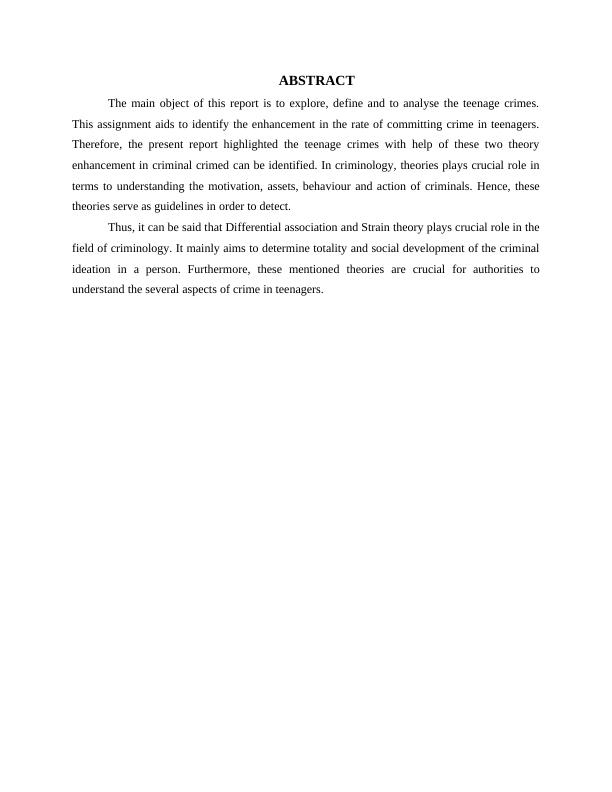Teenage Crime - Assignment
Added on 2021-02-20
7 Pages1941 Words162 Views
TEENAGE CRIMEThe written ReportMAY 2019

ABSTRACTThe main object of this report is to explore, define and to analyse the teenage crimes.This assignment aids to identify the enhancement in the rate of committing crime in teenagers.Therefore, the present report highlighted the teenage crimes with help of these two theoryenhancement in criminal crimed can be identified. In criminology, theories plays crucial role interms to understanding the motivation, assets, behaviour and action of criminals. Hence, thesetheories serve as guidelines in order to detect. Thus, it can be said that Differential association and Strain theory plays crucial role in thefield of criminology. It mainly aims to determine totality and social development of the criminalideation in a person. Furthermore, these mentioned theories are crucial for authorities tounderstand the several aspects of crime in teenagers.

INTRODUCTION: The individuals in the age group 13 to 19 years are known as teenagers. This age durationis very critical and important in the growth and development of an individual. The physical andhormonal changes taking place in this phase of life can have significant impact on thepsychology, behaviour and actions of individuals. Hence, it is very essential that these changesmust be monitored and understand so that teenagers can be provided proper guidance for the lifeand forward career path (Krohn & et.al., 2016). In this age most of the individuals are attractedor forced to commit crime or to involve in illegal activities in the influence of friends, family orsociety. Such teenage crimes have long termed and devastating impacts on the quality of life.Thus, to understand the behaviour which encourages teenage crime various sociology andpsychology theories are used. In this study two theories namely strain theory and differentialassociation theory are discussed and compared. It will provide the relevant evidences whichexplains the teenage crimes through psychological and social theories. Differential association theory In order to describe the criminal psychology differential association theory was proposedby Edwin Sutherland. As per this theory the criminal behaviour is encouraged and influenced bythe social interaction of individuals. This interaction affects the psychology, beliefs, assumptionand values and thus people can be easily motivated for crime actions. This psychological impactbecomes more dominant in teenage. In this growth phase individuals try to explore the worldfrom their own perspective. Thus, when they make social relations and analyse the behaviour oractions of others then they themselves create an opinion and mindset for it. The theory also states that the frequency, priority and duration of the interaction can alsoencourage criminal behaviour. For instance in teenage individuals are highly excited to makefriends and social relations. Thus, they often interact with other without making ethicaljudgements. As a consequence they tend to adopt and follow the same behaviour as followed bytheir families or companions (Walters, 2015). It has been also analysed by this theory that theteenage crimes can be reduced when the teenagers pay appropriate attention to the peer groupsthey are choosing. The parents and mentors must provide guidance to teenagers that how theycan improve the quality of their peer groups. 1

End of preview
Want to access all the pages? Upload your documents or become a member.
Related Documents
Analysis of Strain Theory in Criminology and its Impact on Violent Crimelg...
|7
|2024
|35
Strain Theory of Sociology and Criminology - Assignmentlg...
|11
|2841
|114
(solved) Assignment on Criminologylg...
|9
|2225
|127
Understanding Criminal Behavior and Criminological Theorieslg...
|6
|927
|151
Report on Criminology Critical Analysislg...
|7
|1543
|86
Assignment (Doc) | Criminologylg...
|6
|998
|19
